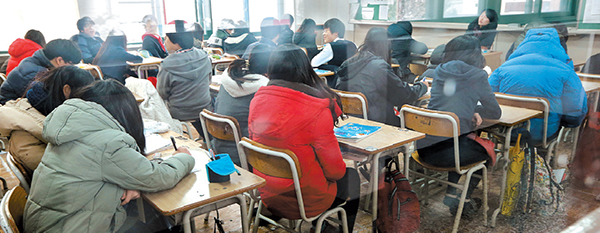Students freeze without renovations

Students at a middle school in Gwanjin District, eastern Seoul, wear padded jackets and hold blankets on their knees during class at 2 p.m. on Dec. 6. By Oh Jong-taek
When the temperature fell to minus 11.8 degrees Celsius (10.8 degrees Fahrenheit) on Monday, students at a high school in Eunpyeong District, northern Seoul, were shivering cold all day long.
When the JoongAng Ilbo visited a classroom, a group of students were huddled together for warmth in the center of the classroom in order to avoid cold air from drafty windows.
“It is too cold to be seated on sides where windows are installed,” a student told the JoongAng Ilbo.
Heat was coming from heaters in the ceiling, but all 34 students in the classroom were wearing padding jackets or coats.
Some students were taking notes with gloved hands.
When the JoongAng Ilbo took the temperature of the classroom, the temperature in the area where students were gathered underneath the heating system was 13.7 degrees Celsius.
The outside-facing wall was 9.2 degrees while the side along the hallway was 6.5 degrees.
The government’s standard for optimal indoor temperature in winter is between 18 and 20 Celsius degrees.
Restrooms were worse than classrooms. A space heater was on in the corner of a restroom, but the air was cold and water pipes had burst.
“We turn on all of our heating systems all day long,” the principal of the school told the JoongAng Ilbo. “But the heated air escapes through those 40-year-old windows.”
The situation wasn’t so different when reporters visited a middle school on Nov. 30.
Though it was 1 p.m., students were wearing mufflers and covering their lower bodies with blankets.
The temperature for the center area of a classroom, underneath the heater, was 15 degrees Celsius.
“My feet are cold if I don’t wear both stockings and socks together,” a girl who is in the 9th grade complained.
Some window frames that looked to be dozens of years old at a glance were badly disfigured, completely failing to block cold wind from outside and preventing hot air from escaping.
“The amount of heating energy consumption in schools isn’t smaller than the amount being consumed in a large government office or corporate buildings,” professor Lee Jae-rim of the Korea National University of Education told the JoongAng Ilbo.
“Many schools in the country need to repair their heating systems or classroom structures including window frames in order to prevent warm air from escaping.”
The JoongAng Ilbo explored five middle and high schools in Seoul whose buildings were built at least 30 years ago and took temperatures from each, it found an average of two to five degrees Celsius difference between where students sat in a classroom.
At a middle school in Gwangjin District, eastern Seoul, as all of the students want to sit in the warm zone, the class allocates students’ seats by a lottery system every day.
“The problem can be easily solved if we install double-pane windows,” the vice principal of the school said. “I really feel sorry for the students.”
The heating systems installed on classroom ceilings, which became a trend in 2000, are inefficient because warm air rises.
Unfortunately, there is no budget for improving school facilities.
The Seoul Metropolitan Office of Education has requested 7.4 trillion won for the 2013 year from the Seoul Metropolitan Council, but the money for facility improvement was decreased by 57.2 percent this year and the budget for heating and cooling systems wasn’t even included.
“Due to the expanded education welfare programs including free lunch programs and personnel expenses, we had to cut the facility management budget.”
By Chun In-sung, Lee Yu-jeong [sakwon80@joongang.co.kr]










with the Korea JoongAng Daily
To write comments, please log in to one of the accounts.
Standards Board Policy (0/250자)